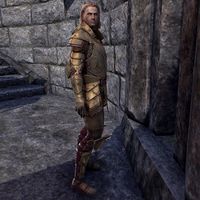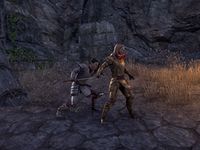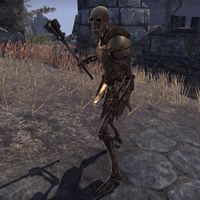Lore:Ranser
| King Ranser | |||
|---|---|---|---|
 King Ranser
King Ranser |
|||
| Race | Breton | Gender | Male |
| Died | 2E 567 |
||
| Resided in | High Rock | ||
| Previous Ruler | Hurlburt | ||
| Appears in | ESO | ||
King Ranser was the ruler of Shornhelm, crowned after the death of his father King Hurlburt of House Branquette in 2E 546. He was illegitimate, born to "a poor Tamrith cousin", and had to compete with his legitimate younger brother Prince Phylgeon Montclair for their father's throne. The fourteen-year-old Phylgeon was descended from House Montclair, and his claim was supported by the codicil to the "Bretonnick Natalitie", which declared "Howse Mount Clayre" the royal house of Shornhelm. However, the codicil was missing when the Council of the North met to discuss the two claimants. Prince Ranser presented a long-lost Direnni decree that named House Branquette their "Breton Royal Delegates" in Rivenspire, winning the crown by the vote of the Council.[1]
Ranser had a daughter named Princess Rayelle, whom King Emeric of Wayrest courted before marrying Maraya in the spring of 2E 566. Furious, he called back his ambassador from Wayrest, staying in Shornhelm when he was invited to Emeric's wedding. In Last Seed of the year, he launched a surprise siege on Wayrest, sparking what is now called Ranser's War.[2] His army consisted of mercenaries, his own people,[3] along with the noble houses of Rivenspire that he forced to fight under his banner. House Tamrith was the first to cease its support and called for peace, followed by House Dorell, while House Ravenwatch remained neutral throughout the war. House Montclair only surrendered to Wayrest right before the Battle of Traitor's Tor.[4] Unsure if his brother's actions were righteous, Count Phylgeon offered to serve as a peace envoy to both Emeric and Ranser, but the latter angrily refused,[1] insistent on winning the war.[5] Overcome by the combined forces of Bretons, Redguards, and Orcs, Ranser's remaining troops were slain at Markwasten Moor, and the end of the conflict gave rise to the Greater Daggerfall Covenant.[3][6] The Crown of Shornhelm as well as the Direnni decree had not been seen since the Battle of Traitor's Tor.[1]
While Ranser himself is thought to be dead,[1] he fled from Markwasten Moor with a small troop of his most loyal soldiers. He prepared a ritual atop a then-nameless tor overlooking Shornhelm, during which he was murdered by his own general. Ranser's blood served as the sacrifice needed for the ritual, transforming him and his warriors into skeletal undead, and the tor from which he ruled became known as Traitor's Tor.[7]
Gallery[edit]
Notes[edit]
- During the mid-Second Era, Shornhelm hosted an annual play called "Ranser! You Madman!".[8]
- Ranser is referred to as a hillmen in the book The Fury of King Ranser.
- Rivenspire in ESO was originally planned to include the spirits of these race of giants that were called "hill giants". The region would have also had Bretons with hill giant heritage called hillmen that were larger than the average person, similar to the half-giant race. These hillmen would have also had some Nordic heritage. Only a loading screen hinting at these hill giant's existence remains in the final game, but the term hillmen still appears as a demonym for Rivenspire's people in the book The Fury of King Ranser in reference to Ranser.
References[edit]
- ^ a b c d Shornhelm, Crown City of the North — Lord Wylon, 39th Baron Montclair
- ^ Triumphs of a Monarch, Ch. 6 — His Majesty King Emeric
- ^ a b The Fury of King Ranser — Wafimeles Masteret (Lorekeeper)
- ^ House Tamrith: A Recent History — Chancellor Regina Troivois, the Department of Interior Affairs
- ^ King Ranser's Tirade — King Ranser
- ^ Guide to the Daggerfall Covenant
- ^ The True Fate of King Ranser — Serinal Gane, Royal Scribe of Shornhelm
- ^ Shornhelm Players Performance Tickets contraband item in ESO

